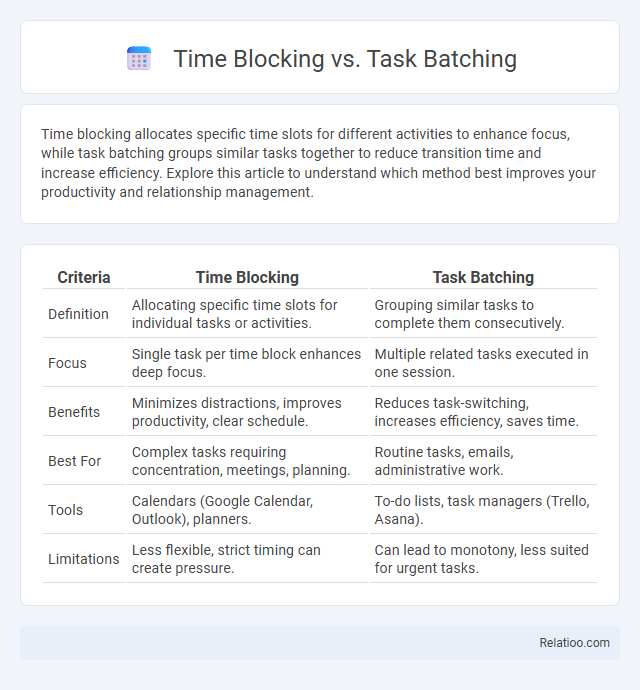Time blocking allocates specific time slots for different activities to enhance focus, while task batching groups similar tasks together to reduce transition time and increase efficiency. Explore this article to understand which method best improves your productivity and relationship management.
Table of Comparison
| Criteria | Time Blocking | Task Batching |
|---|---|---|
| Definition | Allocating specific time slots for individual tasks or activities. | Grouping similar tasks to complete them consecutively. |
| Focus | Single task per time block enhances deep focus. | Multiple related tasks executed in one session. |
| Benefits | Minimizes distractions, improves productivity, clear schedule. | Reduces task-switching, increases efficiency, saves time. |
| Best For | Complex tasks requiring concentration, meetings, planning. | Routine tasks, emails, administrative work. |
| Tools | Calendars (Google Calendar, Outlook), planners. | To-do lists, task managers (Trello, Asana). |
| Limitations | Less flexible, strict timing can create pressure. | Can lead to monotony, less suited for urgent tasks. |
Introduction to Time Blocking and Task Batching
Time Blocking divides Your day into specific segments dedicated to individual tasks, enhancing focus and minimizing distractions to boost productivity. Task Batching groups similar responsibilities together, which reduces the cognitive load of task-switching and increases efficiency by completing related activities in a single time frame. Both methods are powerful time management strategies that help streamline workflows and improve task completion rates.
Defining Time Blocking
Time blocking is a productivity technique where you allocate specific time slots in your calendar to focus exclusively on individual tasks or categories of work, minimizing distractions and enhancing focus. Task batching involves grouping similar tasks together to complete them more efficiently, while reprioritization entails constantly adjusting task importance based on shifting goals or deadlines. Using time blocking helps you maintain a structured schedule, ensuring dedicated periods for high-priority activities and improving overall time management.
Defining Task Batching
Task batching involves grouping similar tasks together to complete them in a dedicated time block, reducing the cognitive load caused by frequent switching. Unlike time blocking, which allocates fixed periods for various activities, task batching optimizes productivity by minimizing distractions and enhancing focus on homogeneous work types. You can improve efficiency by combining task batching with reprioritization techniques that adjust your schedule based on changing deadlines or importance.
Key Differences Between Time Blocking and Task Batching
Time blocking allocates specific time slots for individual tasks or activities, creating a structured daily schedule that prevents distractions and maximizes focus. Task batching groups similar or related tasks together to complete them in one session, reducing the mental load of context switching. Your productivity can improve by understanding that time blocking emphasizes rigid scheduling while task batching centers on efficiency through task similarity.
Benefits of Time Blocking for Productivity
Time blocking enhances productivity by allocating dedicated periods for specific tasks, reducing distractions and ensuring focused work sessions. Your schedule becomes more organized, allowing you to manage workload effectively and meet deadlines consistently. This method minimizes multitasking, promotes deeper concentration, and improves overall time management.
Benefits of Task Batching for Efficiency
Task batching enhances efficiency by grouping similar tasks together, which minimizes context-switching and reduces cognitive load. This method streamlines workflow, enabling deeper focus and faster completion of repetitive activities. As a result, task batching significantly increases productivity compared to sporadic task management approaches like time blocking or reprioritization.
Common Challenges and How to Overcome Them
Time blocking, task batching, and reprioritization each face common challenges such as rigid schedules, decreased flexibility, and difficulty in identifying true priorities. You can overcome these obstacles by incorporating buffer periods in your time blocks, grouping similar tasks for efficient batching, and consistently reviewing priorities to align with evolving goals. Utilizing digital tools and maintaining adaptability helps optimize productivity while minimizing stress across all three strategies.
When to Use Time Blocking vs Task Batching
Time blocking is ideal for activities requiring deep focus and fixed time commitments, such as strategic planning or creative work, ensuring uninterrupted productivity. Task batching suits repetitive or similar tasks like email management or data entry, minimizing transition time and mental fatigue by grouping related activities together. Choosing between time blocking and task batching depends on whether individual attention to distinct tasks or efficiency in handling similar, routine tasks is the priority.
Practical Steps to Implement Each Method
Time blocking requires you to allocate specific time slots on your calendar for focused work sessions, minimizing distractions by turning off notifications and setting clear boundaries. Task batching involves grouping similar tasks together to streamline your workflow and reduce cognitive switching, which can be implemented by sorting your to-do list into categories such as emails, calls, or creative work. Reprioritization demands regularly reviewing and adjusting your task list based on shifting deadlines and goals, using tools like Eisenhower Matrix or priority scoring to ensure you tackle the most critical activities first.
Conclusion: Choosing the Right Strategy for You
Time Blocking, Task Batching, and Reprioritization each optimize productivity by structuring your workflow differently to suit your specific needs. Time Blocking assigns fixed periods for tasks to minimize distractions, Task Batching groups similar tasks for efficiency, and Reprioritization adjusts task order based on urgency and importance. You should select the method that aligns with your work style and goals to maximize focus, reduce stress, and enhance output quality.

Infographic: Time Blocking vs Task Batching
 relatioo.com
relatioo.com